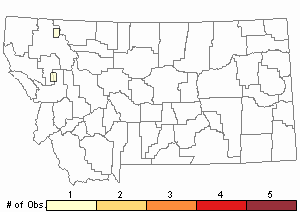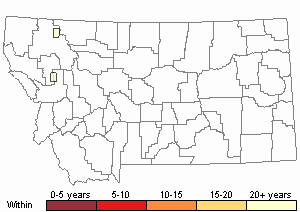View in other NatureServe Network Field Guides
NatureServe
Montana
Utah
Wyoming
Idaho
Wisconsin
British Columbia
South Carolina
Yukon
California
New York
Zierian Hump-Moss - Plagiobryum zieri
General Description
Plants: Acrocarpous. Tufted, pale green to whitish, usually with traces of pink. Stems catkin-like, 8-25 mm in height (FNA 2014), often forked, frequently red (Lawton 1971), innovating freely when gametangia are present (Shaw 1982) below the perichaetia; the innovations sterile (FNA 2014).
Leaves: Those on the main stems upright and overlapping to somewhat spreading when dry, spreading when wet, becoming larger above (FNA 2014), ovate or widely so; apex acute, the lamina ending in a short point that curves backwards; margins smooth, flat, lacking a distinct border (Harpel 2008), the marginal cells 1-layered. Leaves of innovations appressed or overlapping, ovate and widely-rounded to orbicular, concave, 0.7-1.3 mm in length, 0.4-0.8 mm in width; margins flat, smooth; apex acute, ending with an abrupt, recurved point (FNA 2014); costa excurrent, percurrent, or sometimes ending just below the apex; narrow (Shaw 1982), reddish (Harpel 2008). Leaves of innovations are narrower than those of the fertile stems (Shaw 1982).
Leaf Cells: Lower leaf cells 2-4:1; medial cells in mature leaves rhomboidal or more elongate, 2.5-5:1, bulging when saturated, collapsing when dry, the walls thin distally. In innovation leaf X-sections, the dorsal stereid band is mostly 2-3 cells thick or seldom absent (FNA 2014).
Phenology
Capsules ripen from the middle of summer through early fall (FNA 2014).
Diagnostic Characteristics
Bryum argenteum has a leaf shape similar to that of P. zieri, particularly those of the sterile shoots. However, unlike P. zieri, B. argenteum is not tinted with pink, its distal cell walls are somewhat thick rather than thin, and instead of damp areas, it lives in drier places, frequently in habitats that have been altered or supplemented with nitrogen (FNA 2014).
Range Comments
The Zierian Hump-Moss is “a rare circumboreal species,” according to Shaw (1982). In North America, it is known from AK, e to NU, in BC and AB, s to OR, ID, WY and CO; in the east, known from QC, VT, NS, and NL. Also in Greenland, Central America, Europe, Asia, and Africa (FNA 2014). In Montana: Flathead County (Elliott 2016).
Observations in Montana Natural Heritage Program Database
Number of Observations: 2
(Click on the following maps and charts to see full sized version)
Map Help and Descriptions
Relative Density

Recency


 (Observations spanning multiple months or years are excluded from time charts)
(Observations spanning multiple months or years are excluded from time charts)
Habitat
Wet soil and rock (Elliott 2016) of limestone and shale. Elevation: 0-9840 feet, more prevalent in montane to alpine zones (FNA 2014).
Reproductive Characteristics
Dioicous (Harpel 2008). Seta sturdy (Shaw 1982), curved, 6-10 mm in length. Capsules bilaterally symmetric, ochre, 3-5 mm in length (Harpel 2008), drooping somewhat to horizontal, the neck 1-2.5 times the length of urn (FNA 2014); peristome teeth ochre to brown, double; spores frequently remaining attached as tetrads through ripening (Harpel 2008).
Stewardship Responsibility
References
- Literature Cited AboveLegend:
 View Online Publication
View Online Publication Elliott, J.C. and A.K. Pipp. 2018. A Checklist of Montana Mosses (1880-2018). Updated 3 January, 2020. Montana Natural Heritage Program, Helena, Montana. 73 pp.
Elliott, J.C. and A.K. Pipp. 2018. A Checklist of Montana Mosses (1880-2018). Updated 3 January, 2020. Montana Natural Heritage Program, Helena, Montana. 73 pp. Flora of North America Editorial Committee, eds. 2014. Flora of North America North of Mexico. Volume 28. Bryophytes: Mosses, Part 2. Oxford University Press, Inc., NY. xxi + 702 pp.
Flora of North America Editorial Committee, eds. 2014. Flora of North America North of Mexico. Volume 28. Bryophytes: Mosses, Part 2. Oxford University Press, Inc., NY. xxi + 702 pp. Harpel, J. 2008. Species Fact Sheet: Plagiobryum zieri. BLM/USFS Strategic Species in Oregon.
Harpel, J. 2008. Species Fact Sheet: Plagiobryum zieri. BLM/USFS Strategic Species in Oregon. Lawton, E. 1971. Moss Flora of the Pacific Northwest. Hattori Botanical Laboratory. Japan: Yamabuki-cho, Shinjuku-ku, Tokyo. 362 pages plus appendices.
Lawton, E. 1971. Moss Flora of the Pacific Northwest. Hattori Botanical Laboratory. Japan: Yamabuki-cho, Shinjuku-ku, Tokyo. 362 pages plus appendices. Shaw, A. J. 1982. Plagiobryum zieri (Hedw.) Lindb. Disjunct in Guatemala, with Phytogeographic Notes. The Bryologist 85(2)243-250.
Shaw, A. J. 1982. Plagiobryum zieri (Hedw.) Lindb. Disjunct in Guatemala, with Phytogeographic Notes. The Bryologist 85(2)243-250.
- Additional ReferencesLegend:
 View Online Publication
View Online Publication
Do you know of a citation we're missing? Elliot, J. C. 1993. Second checklist of Montana mosses. Unpublished report. U.S. Forest Service, Region 1. Missoula, MT. 45 pp.
Elliot, J. C. 1993. Second checklist of Montana mosses. Unpublished report. U.S. Forest Service, Region 1. Missoula, MT. 45 pp. Lawton, E. 1971. Keys for the Identification of the Mosses on the Pacific Northwest. Reprinted from 'Moss Flora of the Pacific Northwest'. Published as Supplement No. 2 of the Journal of the Hattori Botanical Laboratory. Nichinan, Miyazaki, Japan. 66 pp.
Lawton, E. 1971. Keys for the Identification of the Mosses on the Pacific Northwest. Reprinted from 'Moss Flora of the Pacific Northwest'. Published as Supplement No. 2 of the Journal of the Hattori Botanical Laboratory. Nichinan, Miyazaki, Japan. 66 pp.
- Web Search Engines for Articles on "Zierian Hump-Moss"





